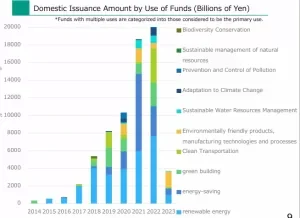A Sustainable Growth Roadmap • Carbon Credits

By 2050, Japan intends to develop innovative strategies poised to reduce atmospheric CO2 globally to “Beyond Zero”. The country’s sustainable growth roadmap contains an effective nature-positive strategy aimed at achieving economic growth and environmental protection.
In December 2022, at the 15th Conference of Parties to the Convention on Biological Diversity (COP15), delegates adopted the Kunming-Montreal Global Biodiversity Framework, outlining global targets for 2030.
The Cabinet under the government of Japan approved the National Biodiversity Strategy 2023-2030 in March 2023 to fulfill its new international commitment. The Transition Strategies toward Nature-Positive Economy were subsequently outlined with the collective decision of the following ministries:
- Ministry of the Environment
- Ministry of Agriculture, Forestry and Fisheries
- Ministry of Economy, Trade, and Industry
- Ministry of Land, Infrastructure, Transport and Tourism
Unleashing Japan’s Nature-Positive Strategy
Japan aims to prioritize nature conservation and uplift its economic policies to transition to a decarbonized future smoothly. Here, we have summarized and explained the significant points from the strategy plan proposed by the Ministry of Environment, Japan.
1. Nature Positive Management
The strategy emphasizes the need for companies to shift towards nature-positive management. The plan focuses on integrating nature preservation methods into their value creation processes. This in turn is expected to open avenues for fostering new economic growth from natural capital.
Conservation and Restoration Efforts: Implementing measures to conserve and restore ecosystems, such as forests, wetlands, and marine environments, to enhance biodiversity and ecosystem services.
Sustainable Resource Management: Promoting sustainable practices in resource extraction, agriculture, fisheries, and other sectors to minimize negative impacts on nature.
The press release from the Ministry of the Environment, under the Government of Japan has elucidated the significance of nature capital to achieve the desired results.
The image shows forest restoration work in Japan.

The report explains that individual companies must consider natural capital as materiality in terms of both risks and opportunities for business activities to shift to nature-positive management. Subsequently, investors will analyze the market to evaluate the performance of the companies handling the natural capital. Based on this performance, further value creation process will be determined.
Simply put, the transition extends to a society where consumers and markets assess companies’ efforts. In NP management, cash flow reform involves collaborative efforts among government, citizens, and integrated nature valuations.
2. Maximizing Business Opportunities
The plan seeks to boost corporate value by disclosing TNFD (The Taskforce on Nature-related Financial Disclosures) and other information, responding to risks with the intent of disclosure. This approach aims to enhance the firm’s resilience and sustainability, which the market and society will evaluate. Consequently, this will attract private capital and elevate corporate value.
The Ministry of the Environment (MoE) has weighed various business opportunities and their market sizes. They plan to create opportunities through sustainable approaches, such as decarbonization, resource recycling, and leveraging natural capital.
One example is adopting environment-friendly aquaculture technology. It would help implement compound and efficient feeding techniques. The market size for this business is estimated to be around 86.4 billion yen annually.
3. Support from the Government
The ministries emphasized the significance of businesses integrating natural capital conservation into their operations. The Japanese government has outlined the following initiatives:
- Going beyond corporate social responsibility (CSR) initiatives. It involves preserving natural capital for both societal and economic sustainability.
- Promote assessing the value of initiatives through the Biodiversity Promotion Activities Promotion Act. Upgrading technologies related to alternative materials, biomimicry, etc.
- Implementing governmental initiatives to facilitate the shift towards a nature-positive economy. Focusing on biodiversity conservation and carbon credit initiatives
- Motivate companies to minimize their carbon footprint and maximize their efforts on nature.
4. Green Infrastructure Development
Japan’s nature-positive strategy also focuses on investing in green infrastructure projects that enhance natural habitats, such as urban parks, green roofs, and permeable pavements.
Identifying and developing OCEMs- Under the green infrastructure development strategy, some specific private lands undergo certification as Other Effective area-based Conservation Measures (OECM) sites. In Japan, diverse locations include the satochi-satoyama, biotopes, conserved forests, and green spaces in cities and factories. OCEMs incentivize efforts by companies and others, extending beyond protected areas.
Developing green infrastructure assures resilience to climate change and numerous benefits to society. Most importantly, it would help generate robust carbon credit.
Japan’s Green Finance Drive: Strengthening Sustainability Investment
The MoE has outlined guidelines for green finance to promote disclosure based on international standards such as TCFD (Task Force on Climate-Related Financial Disclosures) and ISSB (International Sustainability Standards Board), and has promoted regional financial investments for local decarbonization.
Graph: Data released by the Ministry of Environment reveals domestic funds for sustainable growth in Japan.


Japan has estimated 150 trillion yen decarbonization investment over the next 10 years to fortify its domestic green finance. This decision would further abridge domestic and foreign funds directed to Japan’s decarbonization goals.
The dramatic increase in green bond issuance strengthens the financing of a sustainable society. Although the use of funds has been diversifying over the years, renewable energy and energy conservation still dominate most allocations.
However, recently, financing for sectors beyond climate change mitigation, such as biodiversity conservation and resource recycling has just begun.
Boosting J-Credits through the nature-positive economy
According to media reports, Japan envisions,
“A transition to a “nature-positive” economy which covers areas such as carbon and biodiversity credits could create for Japan 47 trillion yen ($309.7 billion) in new business opportunities annually by 2030.”
Like other countries committed to net zero and engaging in carbon credit trading, Japan also participates actively. The government issues carbon credit certificates, known as J-credits. They can be purchased in Japan for carbon offsetting. Boosting J-credits is one way to foster a nature-positive economy.
- The strategy aims to promote the use and creation of forestry J-Credits. It primarily involves the agricultural sector and its role in preserving the biodiversity of Japan.
- J-Credits offer domestic GHG reduction or removals, usable for various purposes including the voluntary emissions trading scheme GX-League
- They promote the J-Blue Credit system about blue carbon projects that sequester carbon within oceanic ecosystems.
J-Credits demand rises in 2024
Reported from offsel.net:
According to the J-Credit System data for 2024, the number of registered J-Credit projects hit a record high of 1,081. Additionally, the certified amount of CO2 emission reductions was 9.36 million t-CO2.

 Source: OFFSEL.net
Source: OFFSEL.net
Japan also intends to engage in international biodiversity credit systems to meet the demand from global industries handling resources outside its national domain.
Furthermore, it has actively engaged with the UK and France in the International Advisory Panel on Biodiversity Credits to discuss future goals for biodiversity credit and offset policies for the country.
From the elaborate information and reports, it seems that Japan has a bright future toward creating a nature-positive economy.



